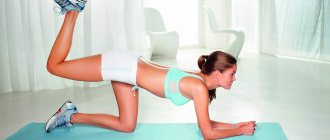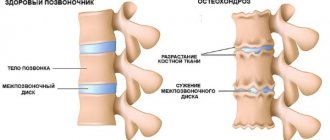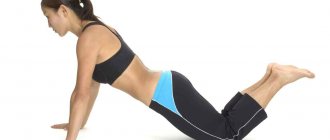Static exercises are a group of specialized exercises, the essence of which is to keep the body motionless. The point of this group of exercises is to apply extreme effort, which contributes to the expenditure of maximum strength, and therefore highly effective training. Today we will consider such a system as static, or as they are also called, isometric exercises.
What are static exercises
This is a group of physical activities and exercises, the main feature is tension without movement, that is, from a mechanical point of view, there is no work. During statistical exercises, the muscles are in a stationary position. A striking example is the traditional plank. While performing the plank, all muscle groups are involved: abs, back, arms, legs, buttocks, neck.
It is a common belief that static exercises require much more effort than dynamics and are unnatural. However, in fact, static loads are just as natural as dynamic ones, when you lift a barbell for biceps, curl on a block, perform cardio exercises, and so on. Another common misconception: statics have no benefits for the body. But if we consider the principle of muscle work during static and dynamic exercises, which we did below, it becomes obvious that statics are as useful and necessary as dynamics.
Why are they needed?
Statics in sports are physical exercises whose benefit lies in the fact that they involve different muscle spectrums, in contrast to dynamic training.
In the process of performing static exercises, the deeper muscles of the body are worked on, which experience minimal stress when performing various movements. In static conditions, they are subjected to exceptionally long-term and targeted loading in a static and stationary mode.
The benefits of static exercises are as follows:
- increasing endurance and strength of the body;
- complete workout of all internal muscles of the body;
- complete and proportional development of muscles;
- development of coordination and balance;
- strengthening tendons along with joints and ligaments;
- improvement of posture.
Static exercises are recommended for the following problems:
- blocking the risk of developing blood stagnation, thrombosis in blood vessels and lymphatic fluid;
- during the recovery and rehabilitation period for bones, joints and muscles that have suffered injuries or surgical interventions;
- practicing other sports that require the development of auxiliary muscular endurance (for example, mixed martial arts, kickboxing, swimming, athletics, boxing);
- excessive body weight;
- violation of the vestibular apparatus and coordination of movements;
- therapy or prevention of pathologies of the musculoskeletal system, carried out by physical therapy;
- improving the muscles of the legs, chest, buttocks, back and arms to create aesthetic appeal;
- improving metabolism in the body.
The best static exercises
We will analyze the TOP 3 training elements for the body, as well as for each muscle group, so that you can create an individual workout.
Static exercises for the muscles of the whole body
1. Plank. This is an effective element that develops not only external, but also deep muscle fiber stabilizers. The beneficial combination of the simplest method of execution and the difficulty of maintaining the original position develops strength, patience, and endurance. Posture improves, core is trained.
So, place your palms parallel to your shoulder joints, place your feet shoulder-width apart, thus forming an even line. It is recommended to tense your abs so that there is no deflection in the lumbar region. At the very beginning, we stand for half a minute or a minute, then increase the time.
2. Reverse plank. This is a variation that also develops the body and has a positive strengthening effect. However, the greater bias here is on the shoulder girdle and back.
Place your hands under the shoulder joint, place your feet hip-width apart, or simply stretch them out. During execution, we make sure that the spine is straightened and the buttocks are in a tense state. Another important point is that you do not need to raise the pelvis too high, as this disrupts the normal position of the lumbar region.
3. Table. We place our palms under our shoulders, place our feet at the level of our hips or a little wider, and squeeze our legs at the knees, forming a right angle. The result is that your heels are under your kneecaps, your hands are under your shoulders, and your core is tense and pointing toward the ceiling. When holding the position, the main tension goes to the abdominal muscles, lumbar extensors and buttocks. It is important to control the tension in the buttocks and core, otherwise the desired result will not be achieved. The pelvis always tends upward, otherwise you can hang on your joints, which is not beneficial for the body.
You can complicate the exercise by performing it with support on only one leg. Based on your level of flexibility, keep your free leg at a right angle or straight. Do the workout on one leg first and then on the other.
Please note that during the exercise there is a large load on the hands. Therefore, it is necessary to first knead them by performing rotations first in one direction, then in the other. If you experience pain in your hands while doing the table, stop doing the exercise.
Static exercises for legs, buttocks and thighs
1. Squat. First, take a standing position, and then lower yourself into a squat, as if doing a classic squat. Ultimately, the thighs should be strictly parallel to the floor line. There is no need to squat too low, as this will increase the load on the knee joints. Your back should be kept straight, your arms can be crossed in front of you or extended forward, depending on how you feel comfortable maintaining your balance. As you perform, make sure that your core, buttocks, and hips are tense. You should start with half a minute, gradually increasing the time. If you are a beginner, you can hold on to a chair.
2. Sumo. This is a variation of the squat that focuses on the inner thigh muscles. You need to take a wide step, spread your legs to the sides. Now we do a squat so that the thighs become parallel to the floor line. In this case, your back should remain straight, your arms can be positioned in any way convenient for you: folded in front of you, placed on your waist or extended forward. You need to feel how the internal pelvic muscles, quadriceps, hamstrings, and buttocks tense. Please note that the greater the leg opening, the more effective the workout will be. If you are a beginner, you can first do shallow squats and help yourself using a chair as support.
3. Chair. First, you need to lean your back against a flat wall and slowly take a sitting position, imagining that you are sitting on a chair. A right angle should form at the knees, and a right angle should also form between the line of the thighs, which are parallel to the floor, and the back. Your arms can take any position that is convenient for you: they can be lowered along the body, placed on the waist or extended forward. As a beginner, you don't have to squat deeply and you can place your hands on your hips.
Static gymnastics for the back
1. Tilt of the body. First, stand facing the wall straight, with your feet shoulder-width apart. The distance between the body and the wall should be approximately 1.5 meters. Then we stretch our arms up and tilt our torso, straightening the spine. Ultimately, your arms should rest against the wall and your spine should form a line parallel to the floor. Make sure that your knees are strictly straight and your back is not rounded.
2. Swallow. This exercise not only strengthens the back muscles, but also develops a sense of balance. First, we take a standing position, then stretch our arms above our heads. We perform a gradual tilt, making sure that the line of the arms and torso is straight. Then we raise and extend one leg so that it continues the line of the arms and torso. Hold this position for at least 30 seconds and then return to the original position. Repeat the exercise, changing legs.
3. Balance on one leg. In this case, the main emphasis is on strengthening the hips. First, we stand up straight, and then raise one leg and bend it at the knee joint so that the thigh line is parallel to the floor line. At this time, your hands occupy any comfortable position. If you are just starting static training, you can support your leg with your hands.
For the press
1. Tilt. This exercise targets the oblique abdominal muscles. We stand up straight and place our feet shoulder-width apart. We raise one arm up and make a deep tilt in the opposite direction (that is, if we raised our right arm, we bend to the left and vice versa). We keep the pelvis straight, do not move it forward, backward or to the sides. We hold the incline for at least 30 seconds, more if possible, and return to the original position. We repeat the exercise, bending in the other direction.
2. Corner. We sit on the floor and straighten our back as much as possible. Then we carefully move our back back, forming an angle of 45 degrees. Please note that you need to sit on the pelvic bones without straining your tailbone. We tense our abdominal muscles. Now we lift our legs off the floor with the force of the press, straighten them and lift them. If it is difficult to keep your legs straight, bend them at the knees. Your arms must be straightened and held in front of you. Make sure your back is in a strictly straight position.
3. Angle with low amplitude. We lie on our backs and stretch our arms along the body, keeping our legs together. Now slowly lift your upper back off the floor and lift it, straining and bending your torso. After this, we raise our feet. During execution, it is necessary to control the tension of the core muscles.
Static exercises for weight loss
1. Shoulder bridge. During execution, the increased load is mainly placed on the muscles of the buttocks and thighs, as a result, calories are effectively burned. So, lie down on your back, bend your knees so that your feet are under them. Now slowly raise the pelvis, forming a straight line. Tightening the buttocks, we maintain a straight line of the body. We make sure that the chest does not protrude and the lower back does not arch. We stand in this position for 30 seconds.
2. Slide. This statistic comes from yoga (also known as downward-facing dog), and it not only has a strengthening effect, fights excess weight, but also increases the flexibility of the body. First, we take the position as for a plank, then we raise the pelvis up, parallel lower the thoracic spine to the floor, and straighten our arms. We aim our tailbone as high as possible. Now we press one leg to the chest, hold in this pose for 4-5 inhalations and exhalations.
3. Boat (hyperextension). We lie down directly on our stomach, and then raise our legs up, keeping them together. Now carefully raise the torso as much as possible. The arms remain straight along the body. You can place your palms under the pelvic bones so that they do not crash into the floor, causing discomfort and pain. The amplitude can be low, the main thing is to control the voltage.
→ How to perform static exercises if your back hurts
How to do isometric exercises correctly
A set of exercises with isometric load can be used to train any muscle group.
Attention ! All static exercises are performed while inhaling.
When analyzing how to do isometric exercises correctly, it should be noted that the effort must be increased gradually, performing 2-3 approaches and devoting time to completing each task:
- novice users - no more than 5-6 seconds;
- experienced – 10-12 seconds;
- the duration of maximum effort for both categories of users is 2-3 seconds.
The interval between approaches is no more than 1-2 minutes. In total, the total complexity of the workout should not exceed 15-20 minutes.
Safety regulations"
When performing this complex, the following rules are observed:
- The optimal training time is morning and afternoon. Large static loads performed in the evening do not allow you to fall asleep for a long time;
- training begins with stretching, preparing the muscles for maximum loads;
- While performing movements, you need to breathe easily and calmly. It will be useful to ventilate the room immediately before training;
- To achieve maximum effect, try to do each exercise technically correctly from the very beginning. For this reason, it is recommended to perform new exercises under the supervision of a trainer;
- during classes, concentrate as much as possible on the body, listening to how the load is applied, building up strength as the work is done;
- You need to start the exercise while inhaling, make any movements smoothly, without jerking;
- exercise regularly, performing 3-4 approaches for each muscle group 5 days a week;
- observe pauses between approaches to restore breathing;
- feel pain in muscles or ligaments, stop exercising;
- After training, it is recommended to take a contrast shower.
Attention ! Performing isometric exercises can cause an increase in blood pressure (blood pressure), so if you experience a headache during exercise, you should stop training immediately.
Suitable equipment and popular exercise machines
The basic exercises included in the isometric training complex are performed with and without additional equipment. Special equipment used for training may include:
- Smith machine;
- horizontal bar;
- power frame;
- gymnastic belt;
- BOSU hemisphere trainer;
- balance board,
- Ultimate Power Frame
- and others.
How muscles work
Our muscles are made up of two types of fibers: fast and slow. Fast-twitch fibers take over the movement during cardio or strength training. Slow fibers are activated during prolonged tension in a particular pose. In order for the development of the body to proceed evenly and proportionally, the body to be healthy and resilient, and the relief to be formed more effectively, it is necessary to regularly engage in not only standard strength and cardio training, but also static training.
What are the benefits of static exercises?
Firstly, they allow you to tone your body. “Static exercises are good because they help work out several muscle groups at once (both large and small), develop endurance and train our nervous system,” says Anatoly Gribov, personal trainer for the gyms of the federal network of fitness clubs X-Fit .
Secondly, compared to dynamic movements, static ones are considered safer. “They are less traumatic and easier to learn. Therefore, they are suitable for beginners, older people, and those who have contraindications to strength training,” explains Valentin Zinin.
Thirdly, static exercises are useful for strengthening ligaments and muscles. However, they do not lead to a strong increase in their volume. This is a plus for those who do not want to pump up .
Also, most static exercises can be performed without additional equipment.
Training Recommendations
To make your workouts effective, use the following tips:
1. Start performing each exercise for 30 seconds, and then gradually increase the duration.
2. Follow the execution technique, accuracy is more important than the period during which you lasted.
3. Combine static and dynamic for more effective weight loss.
4. The optimal duration of each exercise is 3 minutes. Before this, it is better to do dynamic training, activating the work of muscle mass.









